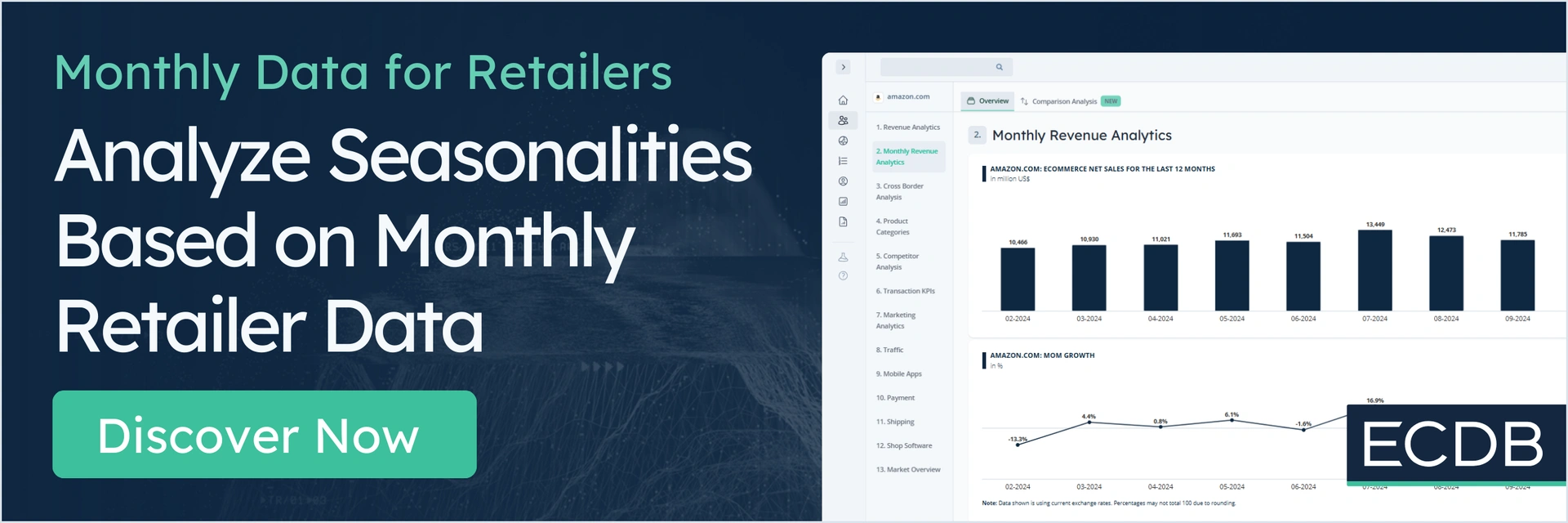Some retailers are thriving where others decline. It is a fact of business which naturally applies to eCommerce as well. ECDB helps find an early cue of online retailer performance by breaking down revenue analysis to the monthly level.
Whereas before, we used the monthly revenue perspective to identify retail growth hotspots, now the story goes in the opposite direction. The question is which online stores stood out with their low performance in the last month.
The immediate view gives us an idea of exactly how retailers perform, without having to wait until the next quarter or whole year to know results. In that vein, who’s leading from the bottom up?
Which Retailers Are Considered in the Analysis
The threshold of retailers needs to exceed US$50 million, to ensure that the analysis remains reliable. Smaller retailers will achieve higher rates of development, just due to the fact that they are reached easier.
While the ranking includes only a selection of retailers with losses that reflect a broader trend, some distinctions must be made. For some, such as biglots.com with a degrowth of 78%, the online store closed recently. In other cases, special circumstances applied like victoriassecret.com, where a security breach halted operations for a time.
These special cases are of course excluded from the depiction. Rather, the analysis focuses on stores that lag due to corporate issues or the market environment.
In the ensuing analysis, a regional clustering is used. It is not an exclusive selection of regions with struggling retailers, however.
United States: Wish, Containerstore, Gamestop, RiteAid
As the second largest eCommerce country in the world, the United States leads global rankings in many categories. In this case, however, the category isn’t the most flattering one. Among losing retailers, four of the ten selected are headquartered in the U.S.
At a -67% year-over-year decline from July 2024 to July 2025, wish.com is experiencing a surprising – or not so surprising elimination from the face of global eCommerce right now. The reasons are a mix of corporate and market environment: Low product quality meets increasing competition from other retailers with a similar strategy, i.e. AliExpress, Temu, TikTok Shop.
Containerstore.com has filed for bankruptcy in 2024, which led to a reorganization of the company’s operations. The online store has taken an according loss over the years, projected to continue throughout 2026. The basic problem lies in a lack of demand in a competitive online environment.
Gamestop and Riteaid have their own set of problems. After Gamestop’s short squeeze, it struggles with declining physical game sales and an underwhelming transition to digital platforms. Rite Aid faces financial strain from mounting debt and increased competition from larger pharmacy chains.
Europe: Westfalia, Leroymerlin, Rueducommerce
Europe is in the middle of global economic developments right now. Tariffs from the one side, Asian competitors from the other, homegrown online stores tend to lose money to remain in business. Westfalia.de at a loss of 31%, leroymerlin.fr at 30% and rueducommerce.fr at 21% tell a tale of affected development.
Westfalia.de in Germany is in a similar position as containerstore.com above. Westfalia sells tools, but filed for bankruptcy, only to reopen an online store in 2024. The home improvement market in Germany is highly disputed, dominated by Amazon online and by physical retailers elsewhere. This makes it hard to gain a stable footing, given the occurrence of marketplaces who sell the same items, but lower-priced.
Leryomerlin.fr and rueducommerce.fr both faced the same problems with their operational processes that it dissatisfied customers to the detriment of online store revenues. These are universal problems that apply to eCommerce without need of especially hindering circumstances of the market environment – customer satisfaction is key, leading to loyalty and repeat purchases.
China: 111.com.cn, Hksuning.com
In China, stagnating revenues are meeting market giants swallowing the whole to leave smaller online stores in the dust. Both 111.com.cn, once a rising star in the online pharmaceutical space, and hksuning.com have seen decreases over 20% in the last month.
The largest platforms in the market, JD Health, Alibaba Health for 111.com.cn and Pinduoduo and JD.com for hksuning.com are making it difficult for the smaller upstarts to thrive in the market environment where larger players determine prices and lower margins.
The selected cases show that many a thing can go wrong in eCommerce: A market environment where consumers are less willing to spend much on retailers that aren’t the largest ones or the cheapest newcomers, cut margins for those retailers who fail to stand out. In other cases, operational inefficiencies lead to the downfall of stores in an unyielding market environment.
The picture that emerges is less about isolated failures and more about a widening gap between those innovating relentlessly and those struggling to keep up -- a gap that shows no signs of closing.










